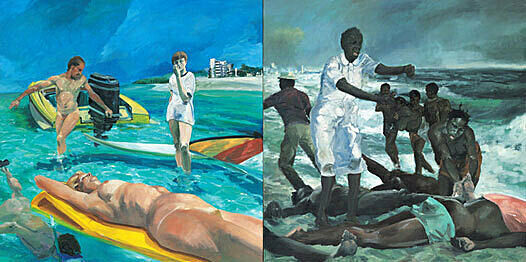On View: Eric Fischl, A Visit to / A Visit From / The Island (1983)
Jul 18, 2013
I, YOU, WE is an exhibition of Whitney collection works from the 1980s and early 1990s by artists who made deeply personal work related to identity, politics, and community. The galleries are organized according to four central themes: “I,” in which artists represent themselves; “YOU,” in which another person is directly addressed; “WE,” in which society as a whole is the subject; and, finally, a gallery devoted to the tragedy of the AIDS crisis.
In the “WE” galleries, I was surprised to come across a work by Eric Fischl as he is often discussed in relation to his provocative psychological subject matter and success in the art market, but not necessarily for his commitment to a particular political ideal or connection to a community. And, yet, Fischl’s painting—A Visit To / A Visit From / The Island—is one of the most potent, politically-charged works in the show.
We are presented with a diptych of two beach scenes: one set on a sunny day off the coast of a posh resort with white people sunbathing and engaging in leisure activities; the other set in a storm with dark-skinned people—possibly Haitian refugees fleeing to Florida, in the midst of a crisis involving a seemingly hopeless rescue. (Critic and curator Robert Storr makes this interpretation in “Desperate Pleasures.” Art in America, November, 1984). Its message is stark and in-your-face: the white people are completely oblivious to the harsh reality experienced by non-whites in these tropical island paradises.
There’s a danger here, though, for the artist in that, if that was all the work had to say, it might come across as overly didactic, or just racist. However, what makes the painting particularly powerful for me is Fischl’s attention to the faces of the two central figures dressed in white. Both are, in their own ways, caught in a dramatic psychological moment. The figure on the left is dressed relatively modestly and chews her nails. She or he appears uncomfortable or unsure about the hedonistic world in which she is situated. The figure on the right appears in a state of terrible emotional pain at the thought of leaving the inert bodies on the shore. Her own body seems to be torn between running for safety and saving the her companions. While part of the appeal of the painting lies in the bluntness of its presentation, these notes of narrative ambiguity allowed me to sink-in deeper, appreciating it on multiple levels.
Gene McHugh, Interpretation Fellow

